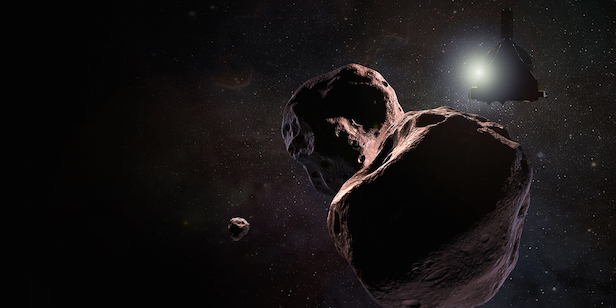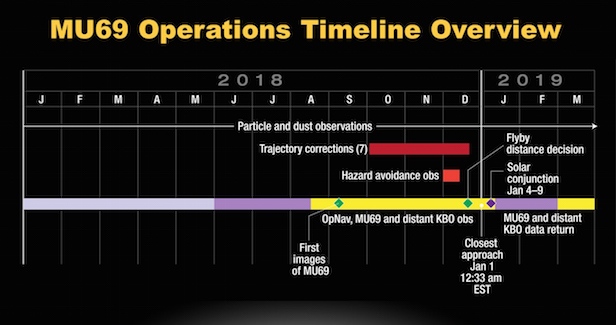The New Year plan for New Horizons
On the 1 January 2019, the New Horizons spacecraft will make a flyby of a Kuiper Object over four billion miles away from Earth

2014 MU69 is a Kuiper Belt object that orbits the Sun 1.6 billion kilometres (one billion miles) beyond Pluto. Image credit: NASA/APL/SwRI/Steve Gribben
To see in the new year of 2019, NASA’s New Horizons spacecraft will visit the most distant and primitive object ever explored on the 1 January 2019. This object, known as 2014 MU69, orbits the Sun over four billion miles from Earth and a billion miles beyond the orbit of Pluto. This encounter will offer the first close-up look at a fundamental building block of the Solar System.
“The Voyagers and Pioneers flew through the Kuiper Belt at a time when we didn’t know this region existed,” says Jim Green, director of NASA’s Planetary Science Division at Headquarters in Washington. “New Horizons is on the hunt to understand these objects, and we invite everyone to ring in the next year with the excitement of exploring the unknown.”
“Our flyby of MU69 on New Year’s Eve and New Year’s Day 2019 will be an exciting sequel to the historic exploration New Horizons performed at Pluto in 2015,” adds Alan Stern, New Horizons principal investigator from Southwest Research Institute (SwRI) in Boulder, Colorado. “Nothing even like MU69 has ever been explored before.”
The Kuiper Belt is the coldest region of the Solar System beyond Pluto, which contains countless bodies of ice and rock, and one of them is the perplexing body MU69. The only information we have gathered on this particular body has come from the Hubble Space Telescope, which discovered the object in 2014, and the New Horizons spacecraft. New Horizons gathered a lot of data on MU69 as it passed in front of three stars, and the results indicated that it could be two objects, with even perhaps a moon.
“That tells us this object is going to have a lot of surprises in store for New Horizons,” says Marc Buie, the New Horizons science team member from SwRI. “We’re going to see something that dates back to the formation of the solar system.”

The timeline of New Horizons operations until the encounter with 2014 MU69 will ensure it reaches the Kuiper Belt object safely while utilising its precious time. Image credit: NASA/APL/SwRI)
In its encounter in 2019, New Horizons will pass the elusive Kuiper Belt object three-times closer than it did with Pluto, allowing the onboard cameras to gain spectacular images with great detail of the surface. Project Scientist Hal Weaver, of the John Hopkins Applied Physics Laboratory (APL) in Laurel, Maryland, United States, emphasised that at an altitude of 3,500 kilometres (2,175 miles), New Horizons will be able to see details about the size of a basketball court.
“Combining images with the measurements we make of the composition of and environment around MU69, should teach us a great deal about objects like MU69 that built dwarf planets like Pluto,” says Weaver.
After the Pluto flyby, NASA induced an extended mission that is centred on this flyby of MU69. Also included in the extended mission is checking out more than two-dozen other Kuiper Belt objects, measurements of plasma, gas and dust within the environment of the Kuiper Belt. “This post-Pluto mission is a complete and comprehensive exploration of the Kuiper Belt,” says Alice Bowman, New Horizons mission operations manager, also from APL. “The spacecraft is collecting data out there throughout each year while the mission team works together to plan and shape the MU69 flyby.”
The New Horizons spacecraft is currently in hibernation until 4 June 2018, and after it wakes up there will be a check of the spacecraft’s systems and instruments. Come mid-August, the encounter with MU69 will official begin, as the spacecraft will begin its long-distance observations of the strange object while the team on Earth navigate it in its path.
Keep up to date with the latest reviews in All About Space – available every month for just £4.99. Alternatively you can subscribe here for a fraction of the price!




